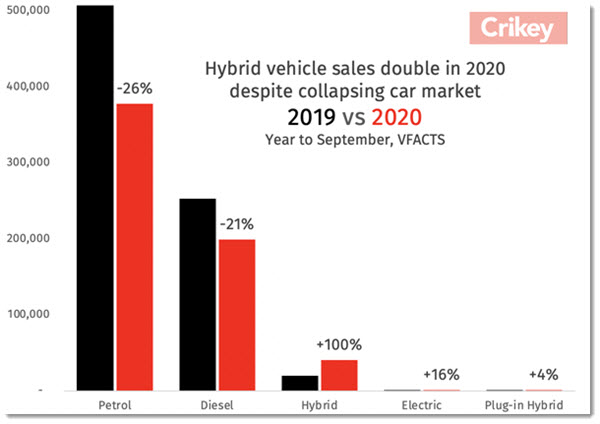

Car sales in Australia have suffered enormously in 2020 — unless you’re selling hybrid vehicles.
The hum of an electric motor is now a familiar one in Australian cities as hybrid engines spread from their incarnation in the Toyota Prius to be available in everything from a Camry to a Cayenne. Sales in the first nine months of the year have doubled, from 20,000 last year to 40,000 this year.
Hybrids still use petrol of course. They’re not a long-run solution for a clean energy future. Australia is unusual in the developed world for having no specific incentives to purchase zero-emissions vehicles.
That didn’t change in the federal budget and it means electric vehicle sales in this country are low and staying low, at about 1200 a year. That excludes Tesla, which reports no data but has limited sales.
Australia’s low-EV sales reflect low global production capacity. Many are in the pipeline, but few are yet in mass production. Norway has achieved a 50% EV market share with huge purchase subsidies, but there is not yet sufficient supply for every country to follow their model.
That will change in the next decade. Leading the charge is Volkswagen with its ID range of vehicles — a hatch, a sedan, a Kombi van, and several more.








Electric delivery vehicles should be compulsory in the cities.
Um… surely, leading the charge to EVs is Tesla, not VW
I agree, it’s not VW building giga factories all over the world and releasing a $25K EV. Tesla will build about 500,000 EVs this year and probably 1,000,000 next year. Next year will also bring their Cybertruck (with pre-sales of 700,000) and $200K 40 ton Semi. Neither VW or anyone else is even close.
Could be a whole new industry building electric cars and employ lots of people, a swag of whom would have a decent amount of expertise already. Julia Gillard made a start offering some sort of incentive to Toyota I think building hybrid vehicles, so I suppose that is the reason this lot won’t do it.
The spread of EV is dependent on ease of charging.
It’s one thing to do it in the city with short runs but the vast distances of the regions require a public utility – solar charged refuelling points throughout the country.
It is so obvious, given that the regions also tend to be the hottest.
Every small town could have sufficient charging capablity for the price of a large urban mcmansion and no further input.
We already have an extensive network. You can actually drive the whole of Oz. https://myelectriccar.com.au/charge-stations-in-australia/
Not quite, but the time is not far off.
Thanks for the link.
VW? Really? You believe them this time?
Well, they do have a very cool looking e-kombi running around. You can see video of it on youtube. If they’re smart they will price it at a level where people can actually afford to buy it.